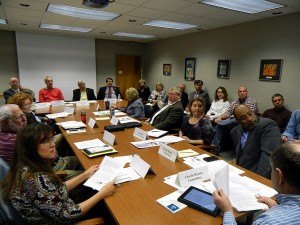
A proposal to resolve a dispute over sales tax revenues and high school debt had majority support during a non-voting joint work session of Oak Ridge City Council and Board of Education on Friday.
Note: This story was updated at 1 p.m.
It hasn’t been approved yet, but a majority of city and school officials on Friday said they support a proposal that would resolve a long-running dispute over whether to use some sales tax revenues collected in Anderson County to help pay for renovations of Oak Ridge High School.
The dispute has centered on how to use a portion of new sales tax revenues collected in Anderson County outside of Oak Ridge under a May 2006 referendum. School officials had argued they could keep that portion of the revenues, but municipal leaders had said the money should be used to help pay down the debt on the $66 million renovation of the high school.
The amount of money in question is in the range of $250,000 to $300,000 annually, although the total varies from year to year.
A new joint resolution that could be considered by the Oak Ridge Board of Education on Monday and the City Council on March 3 would allow the schools to keep its portion of the new Anderson County revenues. (Some of the revenues are also distributed to Clinton and Anderson County schools.) However, the resolution spells out how the money has to be spent in Oak Ridge: on technology enhancements, debt reduction, capital repairs and equipment, and grant matches and innovative educational projects.
The agreement would be in effect until the high school debt is paid or 2041. Most officials said it would allow the two sides to “move forward†and work together.
“I do think this represents a true compromise,” said Bob Eby, Oak Ridge school board vice chair.
“I am very willing to compromise and go (along) with my friends on the school board,†Oak Ridge City Council member Charlie Hensley said. “We’re getting together and putting this issue behind us.â€
Still, there were some questions about the proposal, the product of 100 hours or more of discussion and research, and it’s not clear that it will be approved unanimously.
Oak Ridge City Council member Trina Baughn pressed for details on exactly how much the proposal would cost taxpayers. She said officials were being rushed into a decision that could have an impact for decades. She estimated that having the city make up the $250,000 to $300,000 per year until 2041 could cost about $8 million. She said school officials have been holding money captive since June 2012.
“An election and getting along is not more important than doing right by the taxpayer,†Baughn said.
City Council member Anne Garcia Garland said the school board’s unilateral decision on the county sales tax revenues had severely damaged her interest in cooperating.
“I don’t know what it’s going to take to undo that,†Garcia Garland said.
School officials had argued since at least 2012 that they can keep that portion of the new county sales tax revenues that are collected outside the city of Oak Ridge. Previously, all of that money, as well as the revenues collected inside the city, were used for high school debt payments.
School officials said the money was forwarded to Oak Ridge under a five-year “gentleman’s agreement” and should now be used for operational expenses.
But municipal officials had disagreed. They said the county sales tax increase in 2006 essentially took away money from the city. They argued that the new county revenues, including the money generated outside the city, should be used for debt repayments.
Oak Ridge voters overwhelmingly approved a half-cent sales tax increase for the high school renovations in an August 2004 referendum, but city officials said the subsequent county referendum less than two years later effectively created a new formula for the distribution of sales tax proceeds to Oak Ridge, Clinton, and Anderson County schools.
There has never been a dispute over how to use the new county sales tax revenues collected inside Oak Ridge after the 2006 county referendum—or how to use the revenues collected under the 2004 municipal referendum. Both sides have agreed that those revenues should be used for high school debt.
But the dispute over the county sales tax revenues collected outside the city led to a City Council decision in May 2012 to withhold $766,000 from the schools.
That May 2012 decision was then later blamed as the cause of a $250,000 shortfall that led to the threat of a school shutdown late last summer after the school system failed a state maintenance of effort test. The threatened shutdown was avoided after the Oak Ridge City Council agreed in September 2013 to give the school system another $250,000.
On Friday, Oak Ridge Mayor Pro Tem Jane Miller said the business community and other residents had grown weary of hearing about the dispute, and she welcomed the chance to “move forward.â€
“Compromise never makes everybody happy,” Oak Ridge Mayor Tom Beehan said. “I think the ultimate thing that we got here is moving forward.”
The joint resolution would also have the City Council and School Board set up an annual joint capital improvements program, or CIP, to establish priorities for repairs and replacements, new services, technology enhancements, and public safety as determined by the superintendent and city manager. It would also establish a joint city/education committee to review city and schools priorities and legislation, anticipate future bonding needs, and coordinate with necessary support entities such as the Oak Ridge Education Foundation or state agencies.









Andrew Howe says
Loans, principle and interest. A common scenario with a fairly logical solution, even if not an easy one: Reduce as much interest due over the life of a loan by paying off as much principle as one can, as fast as one can. To get out of debt and lower overall costs of a long term loan, this approach obviously saves a lot of money over the life of the loan, especially when it’s done at the start of the loan payment cycle.
Since there is 27 years left on this loan, I would highly recommend foregoing any and all unneeded spending and instead putting that money toward paying off the principal. Don’t just pay off the loan at the rate set up by the payment plan, overpay it whenever possible.
The problem, of course, is deciding what is “unneeded spending”, which can be a hot debate due to grey areas, unknowns, and dimetrically opposing pros and cons.
The visitors bleachers is a current example. From what I’ve heard, we don’t get a full compliment of visitors at our home games, so perhaps that half million dollars could be put directly into paying off principle and the visitors can just join us on our side to watch the games. Facts, figures, ear-marking of funds and public opinion would weigh in to justify or exclude such a course of financial action, but it’s something to consider.
The future will surely present more opportunities to re-direct spending toward paying off principle, of course.
Hugh Turpin says
Has anyone inquired and considered what the TSSAA requires of the school for seating (number/amount and location or arrangement in the complex) ? I haven’t been to a football game in years, but from the photos I’ve seen posted there are a large number/amount of vacate/not used on both sides of the field…what are the requirements for seating of the band and cheer section ?
johnhuotari says
I’ll try to ask Mike Mullins about that tonight, Hugh.
Sam Hopwood says
I seriously doubt if the TSSAA has any requirements related to seating arrangements. You are correct that there is more than ample seating available for both home and visitors without replacing the visitors bleachers. Most Knoxville schools have seating on only one side of the field and they operate quite successfully that way. Improvements to Blankenship should be made through private fundraising efforts and as John as pointed out, those efforts are underway. Taxpayor funds should be used for needs, not wants.
johnhuotari says
Hugh, Athletic Director Mike Mullins said the TSSAA does not have requirements for football bleachers but does require 1,500 seats for basketball tournaments.
WK Hyatt says
The plan is to reduce the visitors seating from 3400 to 2000 seats, which would be fine for current needs. It depends on who the visiting team is as far as how many fans they bring. If its Farragut, Clinton, Anderson County, or Kingsport DB, and other teams that travel well, 2000 might be close to full, including their bands. DB has a 300 member band, and sometimes they bring them all. Some schools do not travel well and I believe those are times that there appeared to be few on the visitors side. If we become a one-sided Knoxville stadium, then seats will need to be added on the home side, because the total seating capacity of Blankenship is 6554, and take 3400 from that it leaves…3154. So the visitors would need to bring their lawn chairs and blankets and sit on the bank. Most of the Knoxville one sided stadiums probably seat around 5000, and some like Farragut, have visitors sides. Blankenship’s bleachers are worn out, the studies show that, we are doing this because we have run it to failure. It really needs a total renovation, with a combination of public and private funds, if we could get donations for all of it, all the better, but are the big corporate and private donors ready to step up? You know, its not like they have spent a fortune up there over the years, the last major school funded work was in 1979. If they fix it now, and fix it right it could be 50 years before anything major might have to be done. Looking for cost savings, installing field turf would cost @ $500,000 to $600,000. Now that is a lot up front, but, it would eliminate watering, mowing, striping etc. for the life of the turf, which other schools which have installed it say cost them as much as $45,000 a year that they are now saving, so in a few years, you get the money back. Plus, it is better for all weather, and most coaches today prefer it. Sevier County has approved installing in on all 5 of their high school fields and others have done the same. Graham Clark, the Head Coach at Kingsport DB, says its the best decision they ever made. Yes, I have football envy, but I am tried of seeing the place go down, while others do the right thing.
Sam Hopwood says
I don’t want to sound mean spirited but the days of large crowds at Blankenship are long gone. Due to declining enrollment we have dropped to a lower classification and will no longer play DB and Farragut and the other top schools anymore. They have been replaced with Gibbs, Karns etc. Heck, even Campbell County cleaned our clock last year. If you really want to bring back the days of yore get the school lobby to pressure the school board to drop the out of district tutition from almost $4K to, say, $500, and if our schools are as good as the school lobby and school board say they are, enrollment should dramatically increase. Might even pick up a few athletes as well. Works for Alcoa. 🙂
Helen Standifer says
I obviously don’t know all the details but I want to say this. Why do we need ANY improvements to the school? Wasn’t it just built a few years ago (and over budget)? The BOE surely budgets for regular maintenance. And why should taxes collected outside of Oak Ridge be used in Oak Ridge? And, finally, are bleachers at the football field really so important? I don’t know, nothing makes sense to me in this city that I grew up in and love. What happened?
Ellen Smith says
Helen, the deal is that the high school renovation that was just completed hasn’t actually been paid for yet. The city borrowed money to pay for it, and the debt isn’t scheduled to be fully paid off until 2041.
A. Powers says
I am so tired of officials, who hold our future, accepting any compromise or new proposal in a hurry just to get it settled/have public pressure go away. But that is the impression I get from quotes – and not just on this issue. The pressure and concerns are from the citizens who are trying to convey their needs and wants. Isn’t that why we have officials? I obviously don’t know all the details, but published information leads me to believe the “school board-offered” compromise is being considered “as is”. The dictionary defines (true) compromise as “when both parties make concessions”. Trina has the right idea. Get it all spelled out clearly in documented form to assure there are no more “errors in communication” (gentlemen’s agreements) and weigh the whole financial cost for consequences occurring now and for the future. I am not qualified to weigh all of this and decide, and don’t pretend to be. But I get the impression that a lot of potential expenses are considered as more of an individual case and don’t look enough to the whole budget and future consequences or possibly to swap favors (yes, it happens, but shouldn’t, because everyone should be treated the same, as the Bible teaches). (When do we get to vote again?) If I don’t consider my budget, I end up with more month left way beyond my money and I personally pay the consequences. The school system is very important, but does it drive and meet all the needs of the city? Every individual should be represented by the city. I won’t be alive to see the debt paid off if the city continues to let the school board decide this issue, but I will be paying taxes until I depart this world. I am like a large part of the population – retired on a fixed income. I haven’t been retired as long as some, but the rising cost of living in Oak Ridge is a real and rising concern. The minimum charges for sewer and water are for usage beyond my and other’s needs – is that necessary/fair? We are a proud old city. I received an excellent education here. I want Oak Ridge to prosper and grow, but (as you know) we need more people to return and raise their families and share the debt. Some people might not be able to afford the cost of living trade off to come and take advantage of our schools – kind of ironic(?). My opinion – thanks for the opportunity.
p.s. To other commenters: Too bad you can’t cross-reference your bleacher issue comments to that specific article (or can you?) – they are very good and people might miss them here :-} – but I enjoyed them. The comment on principle/interest, etc. had very good points also.
A. Powers says
I just read the Updated article. Apparently the compromise has been updated to be a joint one instead of from school board. The article now states that the schools will be allowed to keep the money, but two joint CIPs will be formed to decide/approve how spent and for them to jointly plan future issues. Where in the compromise did any of the money toward the debt go (?) and why wouldn’t the schools be willing to form these CIPs anyway? FYI for those who didn’t read the article in it’s original form – I’m not making things up. I was commenting on situation as presented. I still stand by my original comments. Mr. Houtari, You do an excellent job keeping the paper updated, but in the interest of “history” it would be nice to have an updated article added leaving original intact or point out changes … just saying – makes us look like idiots and/or feel like we can’t read – I am an ORHS grad :-} Thank you for keeping us informed on issues and providing us a forum to state our concerns and opinions!
A. Powers says
I apologize to the city officials and school board for rude comments I made in haste and frustration to this and other articles on this subject. I truly hate and am uncomfortable with conflict, rudeness, and mud slinging, and I am disappointed and ashamed of myself. I still disagree on the content of the resolution as it was stated in the articles, because there is so much at stake – my opinion. I have only posted to two issues on Oak Ridge Today – both in haste while frustrated. It won’t happen again. If I can’t slow down long enough to think straight and follow the Golden Rule, I just won’t comment.